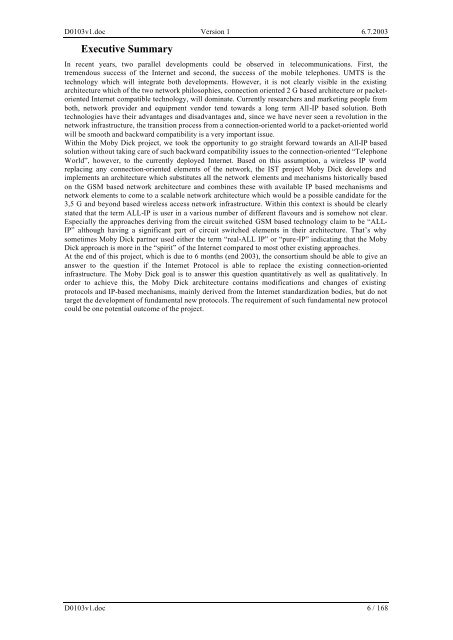Moby Dick Consolidated System Integration Plan
Moby Dick Consolidated System Integration Plan
Moby Dick Consolidated System Integration Plan
Create successful ePaper yourself
Turn your PDF publications into a flip-book with our unique Google optimized e-Paper software.
D0103v1.doc Version 1 6.7.2003<br />
Executive Summary<br />
In recent years, two parallel developments could be observed in telecommunications. First, the<br />
tremendous success of the Internet and second, the success of the mobile telephones. UMTS is the<br />
technology which will integrate both developments. However, it is not clearly visible in the existing<br />
architecture which of the two network philosophies, connection oriented 2 G based architecture or packetoriented<br />
Internet compatible technology, will dominate. Currently researchers and marketing people from<br />
both, network provider and equipment vendor tend towards a long term All-IP based solution. Both<br />
technologies have their advantages and disadvantages and, since we have never seen a revolution in the<br />
network infrastructure, the transition process from a connection-oriented world to a packet-oriented world<br />
will be smooth and backward compatibility is a very important issue.<br />
Within the <strong>Moby</strong> <strong>Dick</strong> project, we took the opportunity to go straight forward towards an All-IP based<br />
solution without taking care of such backward compatibility issues to the connection-oriented “Telephone<br />
World”, however, to the currently deployed Internet. Based on this assumption, a wireless IP world<br />
replacing any connection-oriented elements of the network, the IST project <strong>Moby</strong> <strong>Dick</strong> develops and<br />
implements an architecture which substitutes all the network elements and mechanisms historically based<br />
on the GSM based network architecture and combines these with available IP based mechanisms and<br />
network elements to come to a scalable network architecture which would be a possible candidate for the<br />
3,5 G and beyond based wireless access network infrastructure. Within this context is should be clearly<br />
stated that the term ALL-IP is user in a various number of different flavours and is somehow not clear.<br />
Especially the approaches deriving from the circuit switched GSM based technology claim to be “ALL-<br />
IP” although having a significant part of circuit switched elements in their architecture. That’s why<br />
sometimes <strong>Moby</strong> <strong>Dick</strong> partner used either the term “real-ALL IP” or “pure-IP” indicating that the <strong>Moby</strong><br />
<strong>Dick</strong> approach is more in the “spirit” of the Internet compared to most other existing approaches.<br />
At the end of this project, which is due to 6 months (end 2003), the consortium should be able to give an<br />
answer to the question if the Internet Protocol is able to replace the existing connection-oriented<br />
infrastructure. The <strong>Moby</strong> <strong>Dick</strong> goal is to answer this question quantitatively as well as qualitatively. In<br />
order to achieve this, the <strong>Moby</strong> <strong>Dick</strong> architecture contains modifications and changes of existing<br />
protocols and IP-based mechanisms, mainly derived from the Internet standardization bodies, but do not<br />
target the development of fundamental new protocols. The requirement of such fundamental new protocol<br />
could be one potential outcome of the project.<br />
D0103v1.doc 6 / 168
















